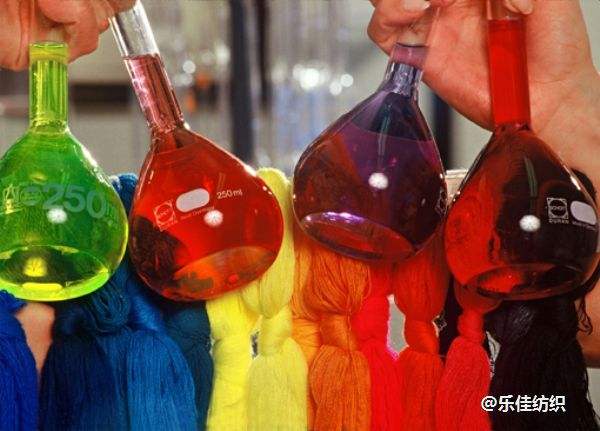Understand dyestuff knowledge, delivery problem
What is Principles and methods for using direct dyes?
The direct dye has a molecular structure in which a water-soluble group such as a sulfonic acid group (-s H) or a radical (-COON) is linearly arranged, and the aromatic ring structure is in the same plane, so that the direct dye has a large affinity for the cellulose fiber. Direct dyeing in a neutral medium, as long as the dye is dissolved in dry water, it can be dyed.
The dye is adsorbed to the surface by the fiber in solution and then continuously diffuses into the amorphous region of the fiber, forming a combination of hydrogen bonding and van der Waals forces with the fiber macromolecule.
Its derived dyes are direct fast dyes and direct copper salt dyes.
direct dye contains water-soluble groups such as -S03Na and COONa, and the solubility increases remarkably with the increase of temperature. For the direct dye with poor solubility, soda ash can be added. Direct dyes are not resistant to hard water, and most of them can combine with calcium and magnesium ions to form insoluble precipitates, which cause stains on dyed fabrics. Therefore, direct dyes must be dissolved in soft water. If the hardness of dyeing water in production is high, soda ash or sodium hexametaphosphate can be added, which is beneficial to both dye dissolution and water softening.
Direct dyes are more direct to cellulose fibers than other dyes. This is mainly due to the large molecular weight of the direct dye, the linear structure of the molecular structure, the good symmetry, the long conjugated system, the good planarity, and the large van der Waals force between the dye and the fiber molecule. At the same time, the direct dye molecule contains a group such as an amino group, a hydroxyl group or an azo group, and can form a hydrogen bond with a hydroxyl group in the cellulose fiber, a hydroxyl group in the protein fiber, an amino group, etc., so that the dye can be further improved.
When the direct dye is dyed with cellulose fibers, the salt acts as a dye. The mechanism of the dyeing is that the direct dye is dissociated into a pigment anion to dye the cellulose fiber in the solution, the cellulose fiber is also negatively charged in the water, and there is a charge repulsion between the dye and the fiber, and the salt is added to the dye solution to lower the electric charge. Repulsive force, increase the dyeing rate and percentage of dyeing. The dyeing effects of different direct dye salts are different. The salt-containing direct dyes containing more sulfonic acid groups in the molecule have significant dye-promoting effects, and the salt should be added in batches during dyeing to ensure uniform dyeing. Direct dyes with a low percentage of dyeing require additional salt addition, depending on the type of dye and the depth of dyeing. Light-colored products with high leveling requirements should be appropriately reduced in the amount of salt, so as to avoid local uneven dyeing, coloring and other dyeing.
The effect of temperature on the dyeing performance of different dyes is different. For direct dyes with high dyeing rate and good diffusion performance, the color is the deepest at 60-70 °C, and the dyeing rate above 90 °C decreases. In the dyeing of such dyes, in order to shorten the dyeing time, the dyeing temperature is 80-90 ° C. After dyeing for a period of time, the temperature of the dye liquor is gradually decreased, and the dye in the dye liquor continues to dye the fiber to increase the dye dyeing percentage. For direct dyes with high degree of aggregation, slow dyeing rate and poor diffusion performance, increasing the temperature can accelerate the diffusion of dyes, increase the dyeing rate, and promote the dye exhaustion in the dye liquor and increase the percentage of dyeing. The temperature at which the highest percentage of dyeing is obtained during the conventional dyeing time is referred to as the highest dyeing temperature. According to the highest dyeing temperature, the direct dye is usually divided into the low temperature dye with the highest dyeing temperature below 70 °C. The highest dye temperature is 70-80 °C and the highest dyeing temperature is 90-100 °C. High temperature dyes. In production practice, cotton and viscose woven fabrics are usually dyed at around 95 ° C, and the dyeing temperature of the silk knitted fabric is low because the excessive temperature is detrimental to the fiber gloss, and the optimum dyeing temperature is 60 to 90 ° C. Properly reduce the dyeing temperature and prolong the dyeing time.
EMPEROR company highly recommend as below:
Direct Red 23, Direct Red 28,Direct Red 31
Direct Yellow 11, Direct yellow 12, Direct yellow 96
Direct Blue 15, Direct Blue 86, Direct Blue 151
Direct Black 19, Direct Black 22, Direct Black 38, Direct Black 168
Direct Brown 1, Direct Brown 2

- Recommended Products:
- Direct Black 168
- Direct Black 56
- Direct Blue 151
- Direct Red 224
- Direct Red 28
- Direct Red 13
- Direct Yellow 27
- Direct Yellow 12
- Direct Blue 108
- Direct Blue 71
- Direct Brown 210
Products Catalog
- solvent red 24
- solvent red 49
- solvent red 122
- solvent red 111
- solvent red 146
- solvent red 195
- solvent yellow 21
- solvent yellow 33
- solvent yellow 93
- solvent yellow 98
- solvent yellow 114
- solvent orange 60
- vat red 41
- solvent green 3
- solvent green 5
- solvent blue 70
- solvent blue 104
- solvent black 3
- solvent violet 31
- solvent violet 13
Copyright right HANGHZOU EMPEROR CHEMICAL CO,,LTD © 2019 All rights reserved.

 Pусский
Pусский